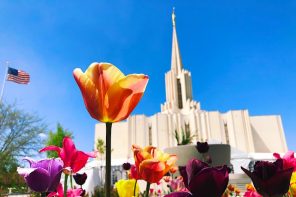It’s been reported this week that the LDS Church has issued guidelines for political involvement by Church leaders. The Church issues official statements declaring its political neutrality every election season, making exception for issues it considers “moral” rather than political—like California’s Proposition 8. (That’s a distinction many would interrogate, especially supporters of LGBT equality.)
But this week’s statement offers something new in drawing a line on who among Church leaders may and who must not participate in any aspect of political campaigning, including endorsing, promoting, donating, or fundraising. Must Nots include full-time Church leaders (a group that would include the Church president, members of leadership bodies, the Quorum of Twelve Apostles, the First and Second Quorums of the Seventy, mission presidents, and temple presidents); Mays include part-time Church leaders (area authorities, stake presidents, and bishops) as long as they don’t fundraise among the people for whom they have ecclesiastical responsibility.
The statement is being viewed as a defensive gesture—a preemptive strike, perhaps—against charges that the LDS Church is officially involved in the campaigns of either Mitt Romney or Jon Huntsman Jr.
To truly get the significance of the statement it helps to understand a little about how the extensive worldwide leadership of the Church is constituted. The LDS Church has an all-lay priesthood—no trained clergy. Just about everyone who attends Church regularly has a “calling,” an officially defined job or responsibility. Men of worldly influence often rise through the ranks to serve as local and regional leaders, handling pastoral and administrative matters. And many are networked, thanks to the social insularity of Mormon communities and the reach of Mormon kinship.
Mitt Romney built a good part of his national machine by mobilizing wealthy and influential Mormons to work their networks enlisting bundlers and donors. A lot of these folks hold leadership positions as well. Given the fact that few non-Mormons understand the lay clerical world of Mormon institutional leadership, it’s clear that the Church would very much like to avoid the appearance that its upper-echelon institutional hierarchy is lining up behind any given presidential candidate.
Perhaps, too, the Church is remembering its experience during the Proposition 8 campaign season, when donor rolls were carefully combed by activists to establish the level of LDS Church member involvement. That research led to the astounding find that more than 50% of the funding for the Yes on 8 campaign came from LDS people, most responding to specific and often very personal “asks” from their Church leaders.
What would happen if folks combed the donor rolls for Romney’s campaign and discovered a pattern of prominent, publicly-recognized, high-ranking LDS Church leaders as bundlers and donors?
With its public statement of policy on political participation by leaders, the Church wants to make it clear: there are no Mormon Manchurian presidential candidates.
Wish we could say the same about ballot propositions.




